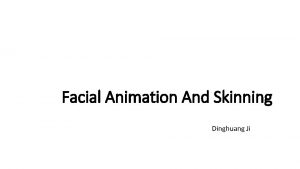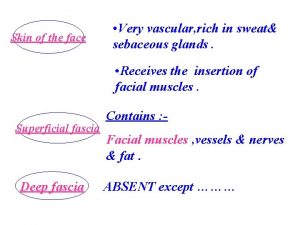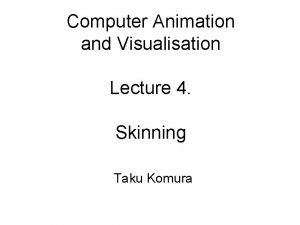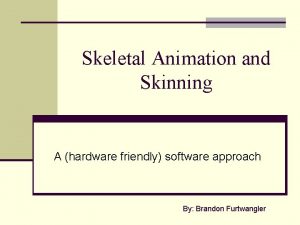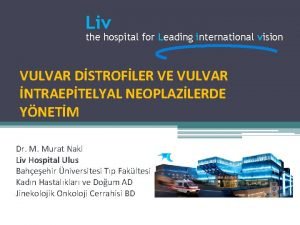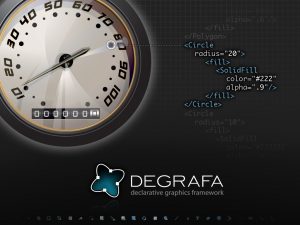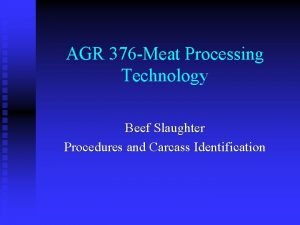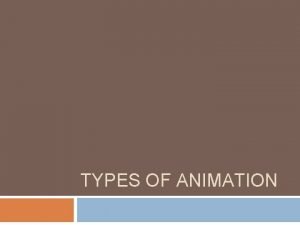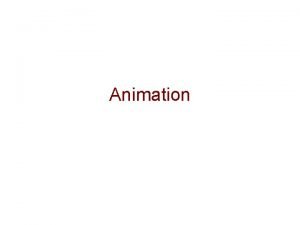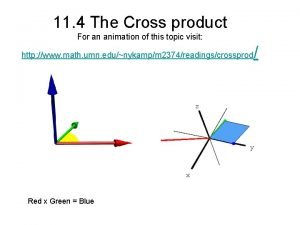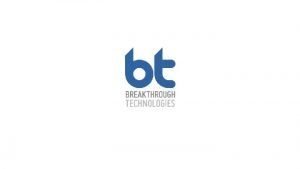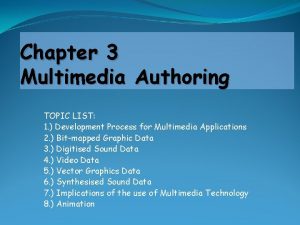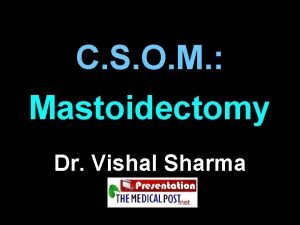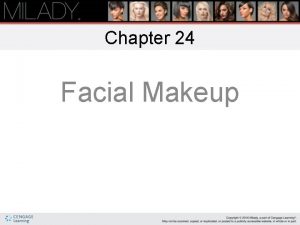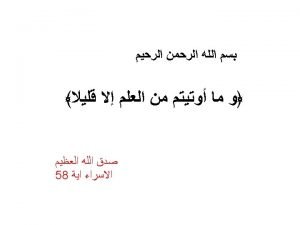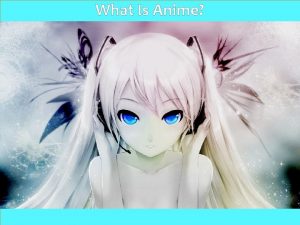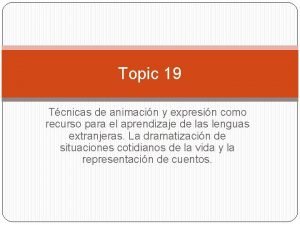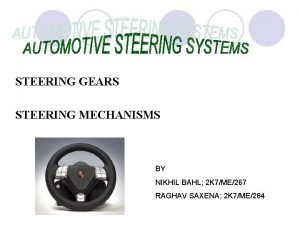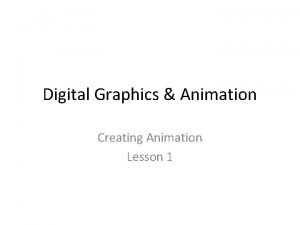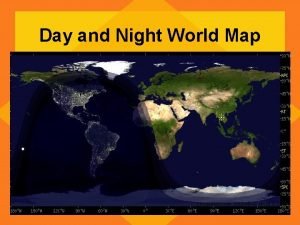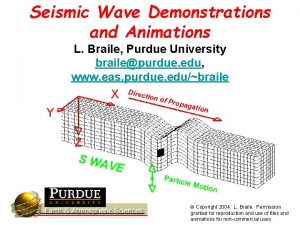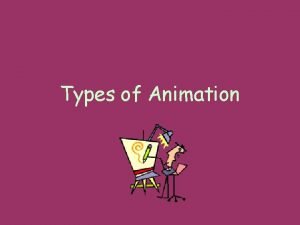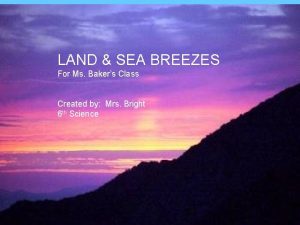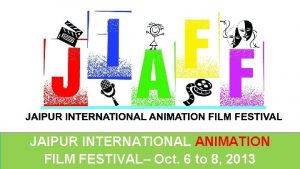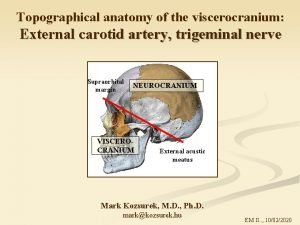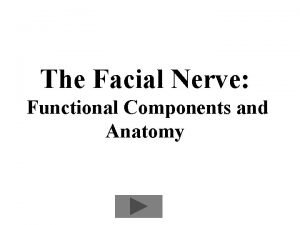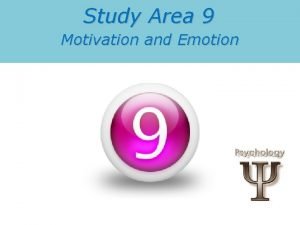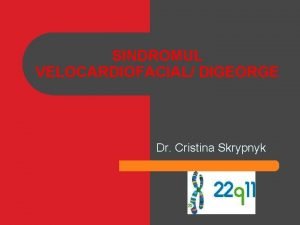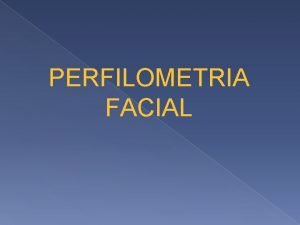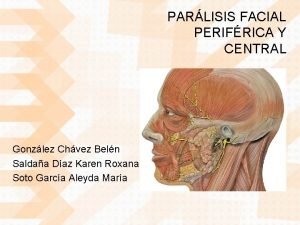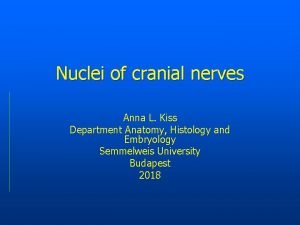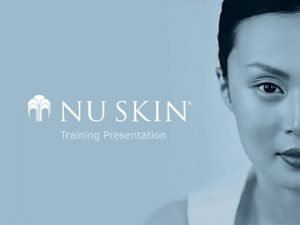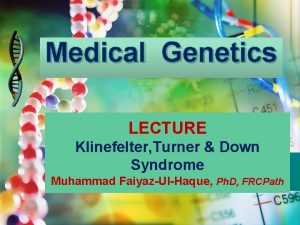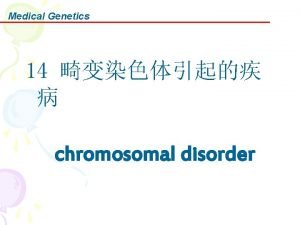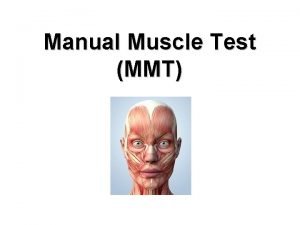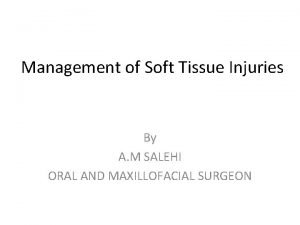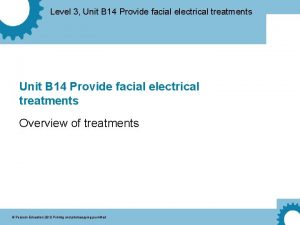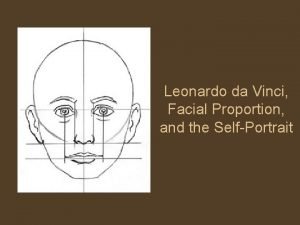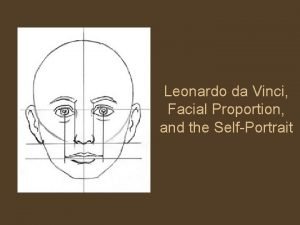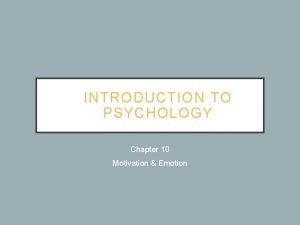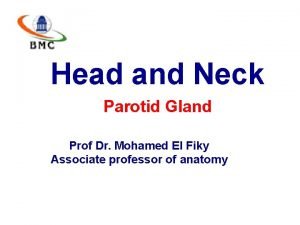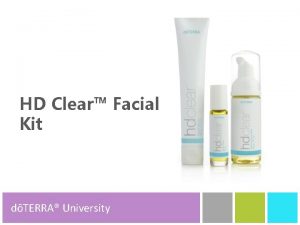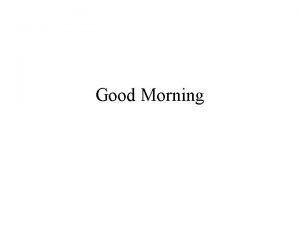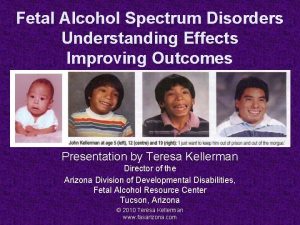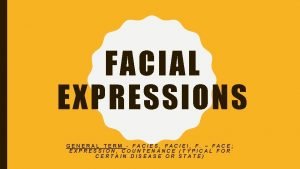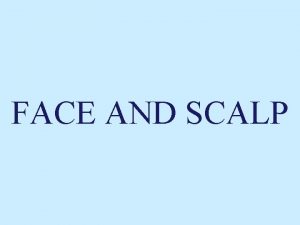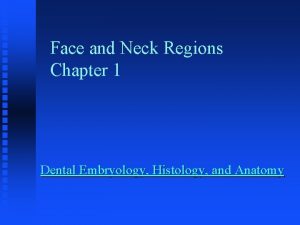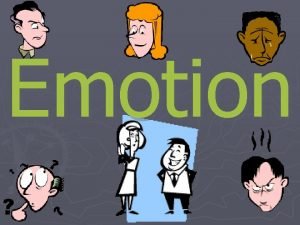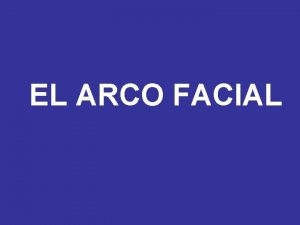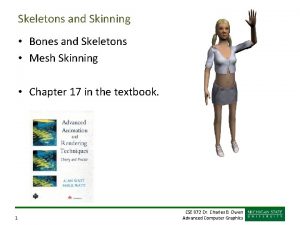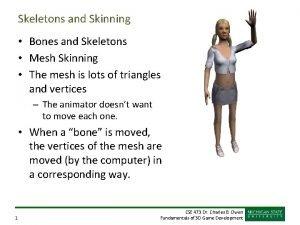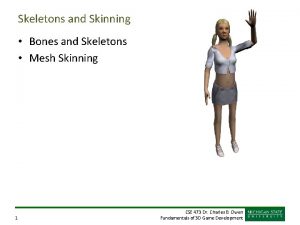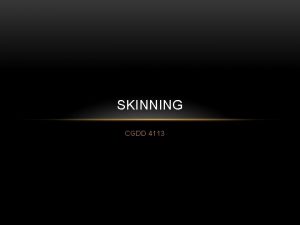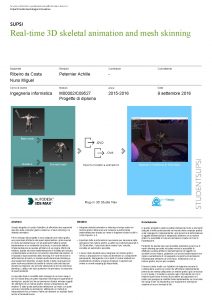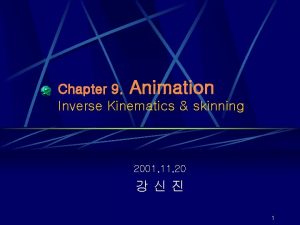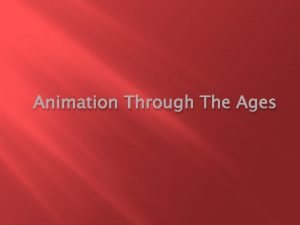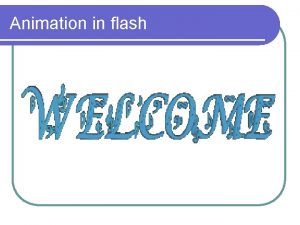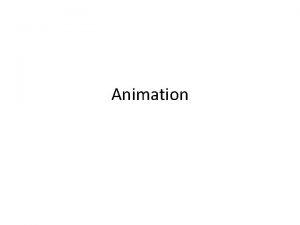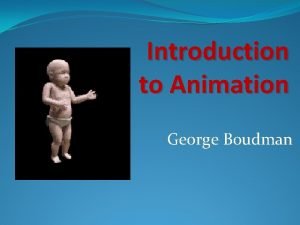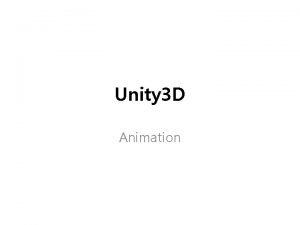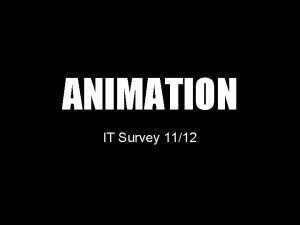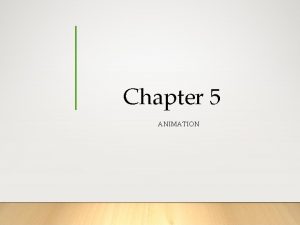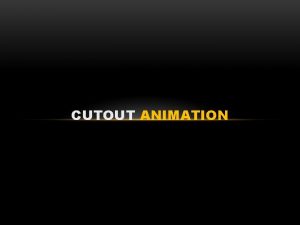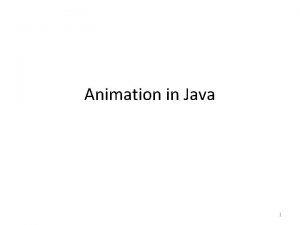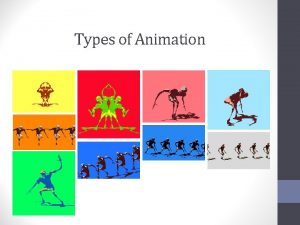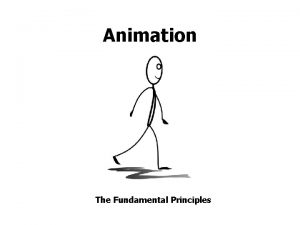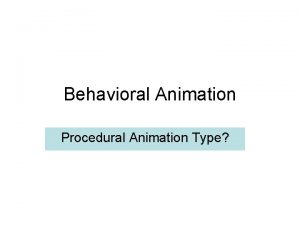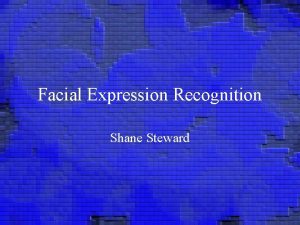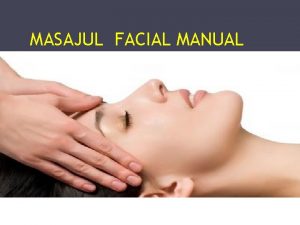Facial Animation And Skinning Dinghuang Ji Outline Definition






![Facial Action Coding System[4] • FACS is a description of the movements of the Facial Action Coding System[4] • FACS is a description of the movements of the](https://slidetodoc.com/presentation_image/357f3a3f1c39cd90b3387ec98b9b44e2/image-7.jpg)






























![Deformation Transfer • Transfer transformations from source polygons to target polygons [9] Deformation Transfer • Transfer transformations from source polygons to target polygons [9]](https://slidetodoc.com/presentation_image/357f3a3f1c39cd90b3387ec98b9b44e2/image-38.jpg)







![Dynamic Response Textures [12] • The linear elastodynamic equation for a finite element model, Dynamic Response Textures [12] • The linear elastodynamic equation for a finite element model,](https://slidetodoc.com/presentation_image/357f3a3f1c39cd90b3387ec98b9b44e2/image-46.jpg)



![Physical Face Cloning [13] • Let X and x denote smooth functions describing the Physical Face Cloning [13] • Let X and x denote smooth functions describing the](https://slidetodoc.com/presentation_image/357f3a3f1c39cd90b3387ec98b9b44e2/image-50.jpg)





![References [1] Z. Deng and J. Noh. Computer Facial Animation: A Survey. DATA-DRIVEN 3 References [1] Z. Deng and J. Noh. Computer Facial Animation: A Survey. DATA-DRIVEN 3](https://slidetodoc.com/presentation_image/357f3a3f1c39cd90b3387ec98b9b44e2/image-56.jpg)
![References [8] J. Y. Noh and U. Neumann. Expression cloning. Proc. of ACM SIGGRAPH’ References [8] J. Y. Noh and U. Neumann. Expression cloning. Proc. of ACM SIGGRAPH’](https://slidetodoc.com/presentation_image/357f3a3f1c39cd90b3387ec98b9b44e2/image-57.jpg)
![References • [14] T. BEELER, F. HAHN, D. BRADLEY, B. BICKEL, P. BEARDSLEY, C. References • [14] T. BEELER, F. HAHN, D. BRADLEY, B. BICKEL, P. BEARDSLEY, C.](https://slidetodoc.com/presentation_image/357f3a3f1c39cd90b3387ec98b9b44e2/image-58.jpg)

- Slides: 59

Facial Animation And Skinning Dinghuang Ji

Outline • Definition of the Problem • History Highlights • Interested Topics • Data driven facial animation • Mesh deformation • Physical based facial animation

Definition of the Problem • (Computer) facial animation is primarily an area of computer graphics that encapsulates models and techniques for generating and animating images of the human head and face[7]. • There are some related topics that I will not cover. 3 D Face modelling requires knowledge of anthropometry and assistance of range scanner or structured light [14][15]. Skin and hair rendering could enhance animation effects[16][17]. Performance driven facial animation supplies intuitive interface[18][19].

Definition of the Problem • This is a well defined problem, but it is difficult to solve. • We are intimately aware of how human faces should look and sensitive to subtleties in the form and motion. • Face expression and head movement work together to convey meaning. • Expressions are further affected by the emotions. • Facial anatomy is both structurally and physically complex: there are many layers of different kinds of material (skin, fat, muscle, bones).

Milestones • In 1970’s, Parke, F. I. build the first 3 D parametric facial model enable generate specific facial animation with few parameters. For example, rotation of the jaw or direction of eye gaze[2]. • In 1970’s, Paul Ekman et. Al. made a standard to encode movements of individual facial muscles. [4] • In the 1980’s, Keith Waters developed a muscle based facial model with physically based skin tissue. [5]

Parke’s Facial Model “Tony de Peltrie” (1985) marked the first time computer facial animation played an important role in telling a story Water’s Facial Model The Pixar short “Tin Toy” (1988) was the first computeranimated film to win an Oscar. The childʼs face is animated using a Waters-style model.
![Facial Action Coding System4 FACS is a description of the movements of the Facial Action Coding System[4] • FACS is a description of the movements of the](https://slidetodoc.com/presentation_image/357f3a3f1c39cd90b3387ec98b9b44e2/image-7.jpg)
Facial Action Coding System[4] • FACS is a description of the movements of the facial muscles and jaw/tongue derived from an analysis of facial anatomy, which includes forty four basic action units. • Combinations of independent action units generate facial expressions

Facial Action Coding System • For its simplicity, FACS is widely utilized with muscle or simulated muscle based approaches. • Limitations: • AUs are purely local patterns while actual facial motion is rarely completely localized • FACS offers spatial motion descriptions but not temporal components.

Muscles of the Face

Uncanny Valley Familiarity Real Person Similarity

Interested Topics Data Driven Mesh Deformation Physical modelling Linear Blend shape Non-Linear Blend shape Temporalspatial analysis Interface design FFD 3 D Morphing Expression Cloning Deformation Gradient Spring-Mass Vector Muscle Vibration model Skin fabrication

What’s blend shape? • Blend shape is a set of geometrical models : • With vertices correspondence • With same topology • Blend shape Interpolation • The weights wk are manipulated by the animator in the form of sliders (with one slider for each weight) or automatically determined by algorithms. vj is the position of jth vertex and Bkj is the positon of jth vertex for kth blend shapes. NBS is the number of blend shapes. • It continues to be used in projects such as the Stuart Little, Star Wars, and Lord of the Rings and was adopted in many commercial animation software packages such as Maya and 3 D Studio Max.

Sidebar: weights • The weights need to be large than 0 and less than 1. W = 1 Outlier Inlier, 0<wi <1 W = -1

Data representation • Mocap Data • Where is the 0 th frame captured from Vicon, which contains NM vertices. Usually we use the 0 th frame as a reference. Each is a 3 dimensional position vector. • Blend shape generation • Capturing the actor’s performance • Compute the boundary of convex set • Obtain through sparse sampling on facial model

Reconstruction Error Minimization • We aim to minimize the reconstructed error with blend shape and weights. Because head moves in the capture process, it’s necessary to remove the movement (rotation) and (translation). And operator remove rotation and translation from jth frame [10].

Numerics • We hope to optimize both weights and blend shapes. The optimized blend shapes should not be far away from initial value. • is the initial value for ith blend shape , is lagrangian multipliers.

Demo

Pros and Cons • This method is very easy to implement and can generate visually good facial animation. • However, the linear blend model can’t generate very natural animation (following some curve) and for some asymmetric expression, it can’t handle very well.

Interested Topics Data Driven Mesh Deformation Physical modelling Linear Blend shape Non-Linear Blend shape Temporalspatial analysis Interface design FFD 3 D Morphing Expression Cloning Deformation Gradient Spring-Mass Vector Muscle Vibration model Skin fabrication

Nonlinear Blend shape • In order to generate more natural animation, we could use nonlinear blend shapes, experiments show cubic polynomial model would be a good choice[11]. • Where is actually linear blend shape . • and have equal dimension with

Numerics • We need to optimize both nonlinear blend shapes and weights, the initial values of and are 0.

Demo

Pros and Cons • This method could achieve more natural expression and smaller reconstruction error. • But because the optimization is a nonlinear problem, it’s more time consuming.

Interested Topics Data Driven Mesh Deformation Physical modelling Linear Blend shape Non-Linear Blend shape Temporalspatial analysis Interface design FFD 3 D Morphing Expression Cloning Deformation Gradient Spring-Mass Vector Muscle Vibration model Skin fabrication

Free Form Deformation • Free-Form deformation (FFD) is a technique for manipulating any shape in a free-form manner. • To compute deformation with FFD, we need to • Generate surrounding grid for object • Compute the homogeneous coordinates using Bernstein polynomial equation • At last, the x, y, z surfaces are mapped to a Bezier surface.

Pros and Cons • This method is easy to implement and running very fast. • But the deformation control is not intuitive, we can’t obtain much details we expected.

Interested Topics Data Driven Mesh Deformation Physical modelling Linear Blend shape Non-Linear Blend shape Temporalspatial analysis Interface design FFD 3 D Morphing Expression Cloning Deformation Gradient Spring-Mass Vector Muscle Vibration model Skin fabrication

Expression Cloning • Transfer vertex motion vectors from a source face model to a target model [8] 1. Determine surface points Correspondence 2. Transfer motion vectors

Dense surface correspondences • Radial Basis Functions (RBF) • Roughly project vertices in the source model onto the target model.

Dense surface correspondences

Dense surface correspondences • Cylindrical Projections

Transfer motion vectors • Barycentric coordinates

Transfer motion vectors • Direction Adjustment • is the rotation matrix between original local space and world space • is the rotation matrix between world space and deformed local space

Transfer motion vectors • Magnitude Adjustment

Expression Cloning • Assume the motion vector of vertex on source model is , the motion vector of vertex on deformed model is

Pros and Cons • This method is intuitive and easy to implement. • But the method is not graceful in formulation.

Interested Topics Data Driven Mesh Deformation Physical modelling Linear Blend shape Non-Linear Blend shape Temporalspatial analysis Interface design FFD 3 D Morphing Expression Cloning Deformation Gradient Spring-Mass Vector Muscle Vibration model Skin fabrication
![Deformation Transfer Transfer transformations from source polygons to target polygons 9 Deformation Transfer • Transfer transformations from source polygons to target polygons [9]](https://slidetodoc.com/presentation_image/357f3a3f1c39cd90b3387ec98b9b44e2/image-38.jpg)
Deformation Transfer • Transfer transformations from source polygons to target polygons [9]

Deformation Gradient is vertex of original triangle and is vertex of deformed triangle v 4 v 3 Original v 1 Q + d v 2 Deformed ?

Deformation Transfer • After build correspondence between original and deformed model, we need to minimize the difference between nontranslational components of the source and target deformations. Here are deformation gradients like Q we just mentioned. is a correspondence of face. • The constraint is added to keep mesh from broken. Is all neighbor faces of

Deformation Transfer • Correspondence Keep close to Identity • are several vertex correspondence assigned manually Closest valid points Smoothness

Limitations • Perhaps the most conspicuous limitation of our technique is the requirement of gross similarity between the source and target meshes.

Interested Topics Data Driven Mesh Deformation Physical modelling Linear Blend shape Non-Linear Blend shape Temporalspatial analysis Interface design FFD 3 D Morphing Expression Cloning Deformation Gradient Spring-Mass Vector Muscle Vibration model Skin fabrication

Physical based Skin modeling • Based on FACS system, Platt et. Al propose a spring mesh system to simulate bone, muscle fiber and skin. Forces are applied to elastic meshes through muscle arcs generate various facial expressions. [6] • Waters proposed a vector muscle model with delineated deformation field which models the action of muscles upon skin. A muscle definition includes the vector field direction, an origin, and an insertion point. The field extent is defined by cosine functions and fall off factors that produce a cone shape when visualized as a height field. Waters animates human emotions such as anger, fear, surprise, disgust, joy, and happiness using vector based linear muscles utilizing the FACS. [1]

Interested Topics Data Driven Mesh Deformation Physical modelling Linear Blend shape Non-Linear Blend shape Temporalspatial analysis Interface design FFD 3 D Morphing Expression Cloning Deformation Gradient Spring-Mass Vector Muscle Vibration model Skin fabrication
![Dynamic Response Textures 12 The linear elastodynamic equation for a finite element model Dynamic Response Textures [12] • The linear elastodynamic equation for a finite element model,](https://slidetodoc.com/presentation_image/357f3a3f1c39cd90b3387ec98b9b44e2/image-46.jpg)
Dynamic Response Textures [12] • The linear elastodynamic equation for a finite element model, describes the displacements of N nodes within a volume. • The displacement field u is expanded in a modal displacement basis • where denotes the model's modal matrix, whose ith column represents the ith model shape, are the corresponding modal amplitudes. Combine the two formulations we get

Dynamic Response Textures • If we make the common assumption of proportional (Rayleigh) damping, then the system of ODEs are completely decoupled by the modal transformation • The system of decoupled ordinary differential equations may be written as • where the undamped natural frequency of vibration and the dimensionless modal damping factor are

Pros and Cons • This method can be used to simulate geometrically complex, volumetric, physically-based, dynamic deformation models with negligible main CPU costs by exploiting commodity graphics hardware. • It’s a generalized method, for facial animation application we need to carefully adjusting parameters.

Interested Topics Data Driven Mesh Deformation Physical modelling Linear Blend shape Non-Linear Blend shape Temporalspatial analysis Interface design FFD 3 D Morphing Expression Cloning Deformation Gradient Spring-Mass Vector Muscle Vibration model Skin fabrication
![Physical Face Cloning 13 Let X and x denote smooth functions describing the Physical Face Cloning [13] • Let X and x denote smooth functions describing the](https://slidetodoc.com/presentation_image/357f3a3f1c39cd90b3387ec98b9b44e2/image-50.jpg)
Physical Face Cloning [13] • Let X and x denote smooth functions describing the position of the skin in its undeformed and deformed state, respectively. • The deformation of the skin at each point can be characterized by the deformation gradient F • We denote the corresponding energy density function by

Physical Face Cloning • The strain energy density of the compressible neo-Hookean material is given as • where and , are shear and bulk moduli, which are related to the familiar Young’s modulus E and Poisson’s ratio as

Physical Face Cloning • We discretize in space using tetrahedral finite elements. The superscript e is used to identify quantities pertaining to a given tetrahedral element. • For example, let and denote position vectors for a given element in its undeformed and deformed state, respectively. • Where Na are piece-wise linear basis functions associated with the nodes of the mesh.

Physical Face Cloning • the discrete elastic energy of a deformed element can be expressed as • where is the element’s parameter domain and its undeformed volume. • The deformed configuration of the skin is then determined as the minimum of the total energy

Pros and Cons • This method combines mesh deformation and physical model and novel optimization scheme that determines the shape of the synthetic skin as well as the actuation parameters that provide the best match to the target expressions. • It’s more time consuming.

Resources in Facial animation • Software and Device : • • • Facegen, could generate a large variety of model and blend shapes Faceworx, vertices texture map generation and modelling Poser, DIY blend shapes 3 ds Max, model editing and animation rendering (vertex plugin) Maya, blend shape plugin Face. Robot, facial rigging and animation Vicon IQ, Blade motion capture and editing Vicon , high frame rate optical marker tracker Structured light, high precision model generation 3 D scanner, high precision model generation
![References 1 Z Deng and J Noh Computer Facial Animation A Survey DATADRIVEN 3 References [1] Z. Deng and J. Noh. Computer Facial Animation: A Survey. DATA-DRIVEN 3](https://slidetodoc.com/presentation_image/357f3a3f1c39cd90b3387ec98b9b44e2/image-56.jpg)
References [1] Z. Deng and J. Noh. Computer Facial Animation: A Survey. DATA-DRIVEN 3 D FACIAL ANIMATION 2007, 1 -28, DOI: 10. 1007/978 -1 -84628 -907 -1_1 [2] F. Parke. Computer generated animation of faces. In Proc. ACM Nat’l Conf. , volume 1, pages 451– 457, 1972. [3] F. I. Parke and K. Waters. Computer Facial Animation. 1996. [4] P. Ekman and W. V. Friesen. Facial Action Coding System. Consulting Psychologists Press, 1978. [5] K. Waters. A muscle model for animating three-dimensional facial expression. In SIGGRAPH Proceedings, volume 21, pages 17– 24, 1987. [6] S. Platt and N. Badler. Animating facial expression. computer graphics. Computer Graphics, 15(3): 245– 252, 1981. [7] http: //en. wikipedia. org/wiki/Computer_facial_animation
![References 8 J Y Noh and U Neumann Expression cloning Proc of ACM SIGGRAPH References [8] J. Y. Noh and U. Neumann. Expression cloning. Proc. of ACM SIGGRAPH’](https://slidetodoc.com/presentation_image/357f3a3f1c39cd90b3387ec98b9b44e2/image-57.jpg)
References [8] J. Y. Noh and U. Neumann. Expression cloning. Proc. of ACM SIGGRAPH’ 01, pages 277– 288, 2001. [9] R. W. Sumner and J. Popovi´c. Deformation transfer for triangle meshes. ACM Trans. Graph. , 23(3): 399– 405, 2004. [10] X. Liu T. Mao S. Xia Y. Yong Z. Wang. Facial animation by optimized blendshapes from motion capture data. Computer Animation and Virtual Worlds 2008. Volume 19 Issue 3 -4, September 2008 pp 235 -245 [11] X. Liu S. Xia Y. Fan Z. Wang. Exploring non-linear relationship of blendshape facial animation. Computer Graphics Forum, doi: 10. 1111/j. 1467 -8659. 2011. 01852. x, 2011 [12] D. L. James, D. K. Pai. Dy. RT: dynamic response textures for real time deformation simulation with graphics hardware. ACM Transactions on Graphics (TOG) - Proceedings of ACM SIGGRAPH 2002. Volume 21 Issue 3, July 2002 pp 582 - 585 [13] B. Bickel, P. Kaufmann, M. Skouras, B. Thomaszewski, D. Bradley, T. Beeler, P. Jackson, S. Marschner, W. Matusik, M. Gross. Physical Face Cloning. ACM Transactions on Graphics (Proc. SIGGRAPH 2012), vol. 31, no. 3, August 2012.
![References 14 T BEELER F HAHN D BRADLEY B BICKEL P BEARDSLEY C References • [14] T. BEELER, F. HAHN, D. BRADLEY, B. BICKEL, P. BEARDSLEY, C.](https://slidetodoc.com/presentation_image/357f3a3f1c39cd90b3387ec98b9b44e2/image-58.jpg)
References • [14] T. BEELER, F. HAHN, D. BRADLEY, B. BICKEL, P. BEARDSLEY, C. GOTSMAN, R. W. SUMNER, M. GROSS. High-Quality Passive Facial Performance Capture Using Anchor Frames. ACM Transactions on Graphics (Proceedings of SIGGRAPH). 2011. (Vancouver, Canada). • [15] Hao Li, Bart Adams, Leonidas J. Guibas, Mark Pauly. ROBUST SINGLE-VIEW GEOMETRY AND MOTION RECONSTRUCTION. ACM Transactions on Graphics, Proceedings of the 2 nd ACM SIGGRAPH Conference and Exhibition in Asia 2009, 12/2009 • [16] Craig Donner and Henrik Wann Jensen. A Spectral BSSRDF for Shading Human Skin. EGSR 2006 • [17] Iman Sadeghi, Heather Pritchett, Henrik Wann Jensen, Rasmus Tamstorf. An Artist Friendly Hair Shading System. ACM Transactions on Graphics 29(4), SIGGRAPH 2010. • [18] Manfred Lau, Ying-Qing Xu and Harry Shum. Interactive Manipulation of 3 D Facial Expressions Using Facial Priors. ACM Transactions on Graphics (Presented at SIGGRAPH 2010), 29(1): Article No. 3. • [19] Jing Xiao and Jessica Hodgins. Vision-based Control of 3 D Facial Animation. ACM SIGGRAPH/Eurographics Symposium on Computer Animation 2003.

Thank you Questions are appreciated.
 Dinghuang ji
Dinghuang ji Cavernous sinus
Cavernous sinus Vertex bone
Vertex bone Hardware skinning
Hardware skinning Skinning vulvektomi
Skinning vulvektomi Flex skinning
Flex skinning Beef skinning cradle
Beef skinning cradle Traditional animation vs computer animation
Traditional animation vs computer animation Sentence outline example
Sentence outline example Animation meaning in computer
Animation meaning in computer Cross product proof
Cross product proof Drupal amazon ses
Drupal amazon ses Stages of multimedia application development
Stages of multimedia application development Facial ridge and bridge
Facial ridge and bridge Milady chapter 24 review questions answers
Milady chapter 24 review questions answers Umnl and lmnl
Umnl and lmnl Anime
Anime Topic 19 animation and expression techniques
Topic 19 animation and expression techniques Worm and sector steering gear animation
Worm and sector steering gear animation Land breeze and sea breeze animation
Land breeze and sea breeze animation Digital graphics and animation
Digital graphics and animation Day and night map
Day and night map Love and rayleigh waves animation
Love and rayleigh waves animation Pros and cons of stop motion animation
Pros and cons of stop motion animation Interphase
Interphase Land and sea breeze animation
Land and sea breeze animation Animation and film making school in jaipur
Animation and film making school in jaipur Ophthalmic artery branches off
Ophthalmic artery branches off Functional components of facial nerve
Functional components of facial nerve James lange theory
James lange theory Sindrom velo cardio facial
Sindrom velo cardio facial Angulo nasolabial
Angulo nasolabial Paralisis facial periferica y central
Paralisis facial periferica y central Osha facial hair chart
Osha facial hair chart 12 carnial nerves
12 carnial nerves Nu skin facial cleansing bar
Nu skin facial cleansing bar Facial muscle mmt grading
Facial muscle mmt grading Monosomy x
Monosomy x Klinefelter syndrome facial features
Klinefelter syndrome facial features Face mmt
Face mmt Bupivacaine lidocaine
Bupivacaine lidocaine Level 3 electrical facial
Level 3 electrical facial Da vinci guide to facial proportions
Da vinci guide to facial proportions Leonardo da vinci face proportions
Leonardo da vinci face proportions Chapter 10 motivation and emotion
Chapter 10 motivation and emotion Apex of parotid gland
Apex of parotid gland Doterra hd clear kit
Doterra hd clear kit Striae pontis
Striae pontis Teresa kellerman
Teresa kellerman Fas facial features
Fas facial features Fas facial features
Fas facial features Inferior labial nerve
Inferior labial nerve Facies oleosa
Facies oleosa Facial vein
Facial vein Palatine fovea
Palatine fovea Carroll izard 10 basic emotions
Carroll izard 10 basic emotions Arco facial dentatus
Arco facial dentatus James lange theory
James lange theory Lateral cleft lip
Lateral cleft lip Facial prominences
Facial prominences
